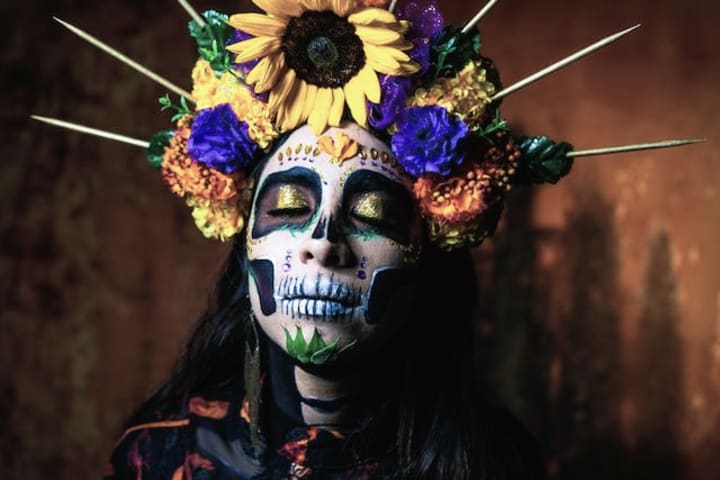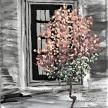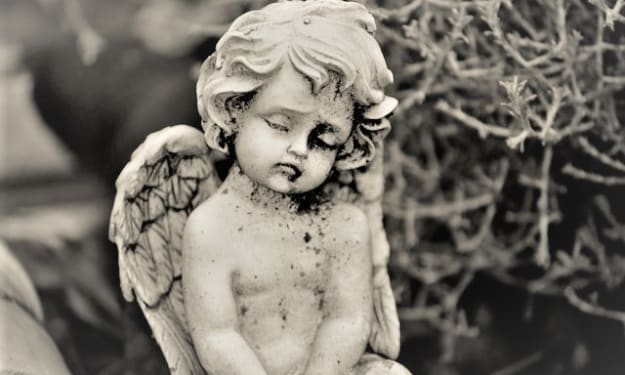Dia de los Muertos
Abuelita

It was November 2nd, the last day of el Dia de los Muertos. Carmen Maria Isabella Sande Junquera entered the cathedral, pausing to dip her fingers in the holy water basin and bow to the crucifix while crossing herself. Candles lit the cathedral as far as she could see, their lights bouncing off the massive 24-karat décor. Though it was dimly lit, Carmen observed the church appeared to be vacant. Where was everyone? This was abuela’s funeral mass and her abuelita knew more than half the town. It was unthinkable that no one had shown up for it save her granddaughter.
Very confused and wide-eyed, Carmen looked down at her feet. ¡Dios mío! Why in heavens name was she wearing her best huipil or formal, multi-colored dress? She should be wearing traditional funeral attire. Her Mamá would never let her end of it! Nervously, she smoothed the black mantilla that covered her head. At least she’d shown some respect and worn the head covering. The black lace mantilla was special; it had belonged to abuelita.
Best to take a seat and wait for the others, she thought and started down the aisle. Surprised by what she saw, she paused midway. Who were those three people silhouetted by the dim lights, standing directly in front of the altar? It didn’t look like Father Junco or altar boys. Whoever they were, Carmen didn’t know them.
¡Que extraño! What exactly was going on? This was all too strange, especially since no family or friends appeared to be in attendance.
Taking a deep breath, Carmen made her way to the altar, intending to only nod in greeting at the three unknown figures and then take a seat to await her family’s arrival. As she neared the end of the aisle, however, she was able to better see the three figures. Frightened, she dropped the pan dulce de muerto - or sweet bread - she carried and screamed. Now she was close enough, she could make out the three figures and the sight horrified her. She'd never met any of them, and yet, Carmen strangely recognized all three.
Standing directly in front, dead center, was none other than Frida Kahlo. She was flanked by a female Catrina and a male Catrin, each skeletal figure garish and ghastly while still superbly suited exactly how Frida and her spouse, Diego Rivera, had depicted them in pieces of art. If not for the shock, Carmen would have been impressed.
¿Que diablos? Carmen muttered but then quickly reminded herself she shouldn't cuss, especially in church. Still, the situation was more than alarming. It was 1976 and Frida had been dead for twenty-two years, but Carmen would have recognized her anywhere. The uniceja or unibrow took precedence, just as it always did in the pictures Carmen had seen. Though in church, Frida wore traditional men’s attire: pants, waistcoat, shirt, tie, and jacket. She was splendid, and all Carmen could do was stare. She must be dreaming – or dead.
“Bienvenido, Carmen,” Frida smiled and walked over to lightly touch Carmen’s arm. “We have been awaiting your arrival.”
“My arrival?” Carmen was beyond confused - and utterly afraid.
“Sí, querida,” Frida waved her arm. “We have all been anxious for the time you would join us.”
Carmen turned in the direction gestured by Frida and saw that the entire basilica was now full of la calavera or skeletal figures, each dressed in best formal attire.
Fear gripped and twisted around Carmen’s heart like an encroaching vine. She glanced down at the discarded pan dulce that she had intended to leave on the altar to honor her abuelita in the afterlife. Perhaps the pan dulce was hers instead for she must be dead. Speaking of which, if that was the case, where was her abuelita? Abuelita should be there to embrace and guide her to the afterlife. This was damn scary – a pesadilla or nightmare from which she wished to awaken.
Of a sudden, Frida turned to the right and greeted a figure walking toward them. ¡Finalmente! Illuminated by what appeared to be a thousand lights, Carmen’s abuela approached, looking as if she were floating on the air. Abuela had never looked so lovely, so youthful, or so happy. Carmen’s heart filled with joy and she wiped at her tears.
“¡Abuelita! ¡Estoy tan feliz de verte!” Never had she been so happy to see her grandmother!
“Te quiero, corazón. Todo está bien,” her grandmother replied to assure her granddaughter she was loved and all was well. Comforted, Carmen closed her eyes and felt her abuela's warm embrace as she kissed Carmen's tear streaked cheek.
After long moments, Carmen opened her eyes and found she was no longer inside the basilica. Instead, she was at the cathedral’s massive entry doors. Had she truly never entered?! Now alone, she glanced down to find her dress was no longer colorful, but the traditional black one, befitting of the occasion. She still held the pan dulce that she had baked with love that morning. Quickly, she looked all about, her eyes catching sight of her family, who were now climbing the steps of the cathedral.
¡Dios mío! It had all been a dream – or had it? In her heart, Carmen knew that abuelita had visited on this dia de los muertos if for nothing else, to tell her adiós. Carmen smiled, both because of the relief she was still alive and because she felt uniquely special. She would spend today celebrating abuelita's life and would not waste time mourning. She now knew abuelita lived on far beyond her mortal existence.
Still, Carmen had to admit she was not completely surprised. Was all this not to be expected of abuelita? Carmen knew she was abuelita's favorite grandchild, after all. She stifled a small laugh, cognizant of the fact her mother would not appreciate the sound. With renewed determination, she pushed against the heavy doors and prepared to enter the cathedral. Before, she had been dreading today’s mass, but now she looked forward to it with new enlightenment and a much brighter perspective of where her abuelita really was.

Notes & References:
La Catrina or La Calavera Catrina, originally created by Jose Guadalupe Posada in 1910 was made more famous by Mexican artist, Diego Rivera, and his spouse, Frida Kahlo in a mural painted in 1947 and entitled “Dream of a Sunday Afternoon” . The mural is housed in the Zocalo or Mexico City's center.
In present day Mexico, la Catrina is linked to the celebration of el Dia de los Muertos almost seamlessly through art, face paint, elegant dress, music, and festivals. La Catrina gives a nod to the ancient Aztec queen of the underworld. El Dia de los Muertos is celebrated each year from November 1st through 2nd and honors the lives of the departed rather than a perpetuation of mourning for them.
https://thegracemuseum.org/learn/2020-11-2-la-catrina-a-history/
https://en.wikipedia.org/wiki/Day_of_the_Dead

About the Creator
Cindy Calder
From Charleston SC - "I am still learning." Michelangelo






Comments (1)
Whoaaa, the shadowy figure being Frida Kahlo was an awesome twist! So happy that abuela had visited Carmen. I loved your story!